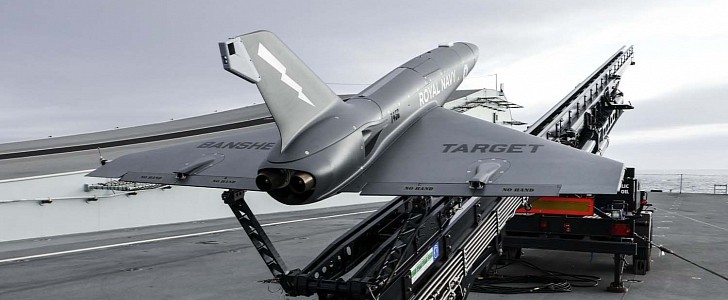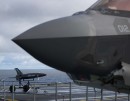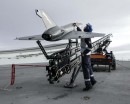After having been introduced to the F-35 fighter jets recently, the Royal Navy’s latest aircraft carriers are preparing to carry drones onboard for future operations. These powerful drones that look like miniature fighter jets turned out to be perfect for anti-missile training.
HMS Prince of Wales, the second Queen Elizabeth-class aircraft carrier, commissioned in 2019, became the first Royal Navy ship to carry and launch jet-powered drones for demonstration purposes. The Navy is looking to operate crewless technology from these new aircraft carriers in the future, and this was one of the first steps.
The QinetiQ Banshee Jet 80+ drones are jet-powered, fixed-wing drones that fly at 460 mph (400 knots), can skim above the water (which makes them hard to detect by radars), and can raise to 25,000 feet. According to the Navy, these characteristics make them similar to incoming missiles, which means they can be a great alternative for mock aerial threats in training exercises.
During this recent demonstration, engineers from QinetiQ, the company that operates the Banshee drone, operated three unmanned air vehicles (UAVs) from the HMS Prince of Wales’ drone launcher, off the northwest coast of Scotland.
The crew on board wanted to determine the best way to integrate the drone and all the support equipment on the warship’s deck. Especially at this particular moment, when the ship was already busy with F-35B Lightning jets training and participating in the massive Joint Warrior exercise.
The Banshee drones also have the advantage of being affordable and versatile enough to carry different types of payload. This is why the Navy also plans to use them in tests for sensors, radio equipment, and different types of weapons. The goal is to equip all warships with these types of drones so that the task groups can practice air defense no matter where they’re deployed.
Enabling aircraft carriers to operate unmanned air vehicles is part of a larger program, called Project Vampire, focused on the potential benefits of lightweight, fixed-wing drones.
The QinetiQ Banshee Jet 80+ drones are jet-powered, fixed-wing drones that fly at 460 mph (400 knots), can skim above the water (which makes them hard to detect by radars), and can raise to 25,000 feet. According to the Navy, these characteristics make them similar to incoming missiles, which means they can be a great alternative for mock aerial threats in training exercises.
During this recent demonstration, engineers from QinetiQ, the company that operates the Banshee drone, operated three unmanned air vehicles (UAVs) from the HMS Prince of Wales’ drone launcher, off the northwest coast of Scotland.
The crew on board wanted to determine the best way to integrate the drone and all the support equipment on the warship’s deck. Especially at this particular moment, when the ship was already busy with F-35B Lightning jets training and participating in the massive Joint Warrior exercise.
The Banshee drones also have the advantage of being affordable and versatile enough to carry different types of payload. This is why the Navy also plans to use them in tests for sensors, radio equipment, and different types of weapons. The goal is to equip all warships with these types of drones so that the task groups can practice air defense no matter where they’re deployed.
Enabling aircraft carriers to operate unmanned air vehicles is part of a larger program, called Project Vampire, focused on the potential benefits of lightweight, fixed-wing drones.













